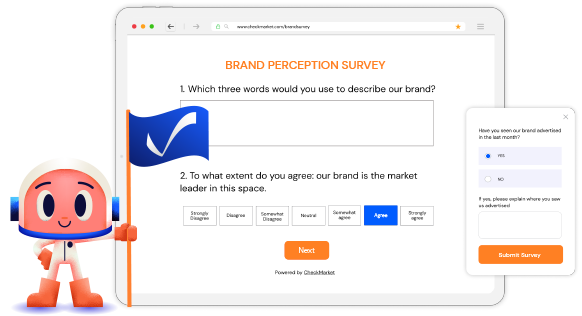One of the most effective ways to measure satisfaction in a survey is by using a Likert scale. These scales allow respondents to choose how they feel about a topic using gradient answers.
A Likert scale gives you measurable data that will help you improve your business, make changes to a product, or enhance the customer experience.
This guide will give you five Likert scale examples that you can use in your next survey.
What is a Likert Scale?
Likert scales get their name from their inventor, psychologist Rensis Likert. He was looking for a way to measure human attitudes and created his Likert scale in 1932. Since then, Likert scales have become standard practice for survey research.
These scales typically include a range of 5 to 7 response options like “strongly agree,” “agree,” and “slightly disagree.” Likert scales usually include a neutral option in the middle. Each statement is given a numerical value, which is used to calculate the results of each question.
While most Likert scales include a range of five options, some scales include as few as three or as many as 11. However, the larger and smaller scales tend to have problems where respondents do not want to choose the extreme answers, or the scale does not provide enough differentiation between answers.
Likert scales are an excellent way to get specific feedback on your desired topic, especially if you are looking for areas of improvement.

When to Use a Likert Scale
Likert scales are ideal for getting precise details about your chosen issue. Use a Likert scale to gauge reactions to specific events like these:
- After introducing a new product
- How your employees feel about recent office changes
- What your customers think about your customer service
- How the public felt after attending one of your events
Along with these types of situations, you should also consider using a Likert scale anytime you want precise responses to a specific occurrence or product. Consider it for variations in likelihood, importance, quality, and frequency.
How to Create a Likert Scale
In order to get the information you need from your Likert scale survey, you need to ask the right questions. The more detailed you are in your survey, the more variance you will get. (Variance is a technical word for high levels of detail in a survey.) The more variance you add to a survey, the better your results will be.
To create a Likert scale that reduces bias, it is important to do the following:
- Phrase your questions as statements: Instead of asking yes or no questions, pose your question as a statement of fact. For example, “I am satisfied with my online shopping experience.” The respondents would choose their answer based on their level of agreement. The score averages are a great way to track your progress over time.
- Include both positive and negative statements: By including both positive and negative questions, this can weed out any respondents who rushed through and chose the same answer for everything. It can be beneficial to include these questions as pairs. For example, include a statement like “I appreciate the wide variety of products found online” paired with “I feel overwhelmed by too many options online.” Someone who agrees with the first statement should disagree with the second. If they don’t, their answers might be unreliable.
- Use survey best practices when creating questions: Avoid long, complicated questions. You also want to stick with neutral language. Do not use words like ‘love,’ ‘hate,’ ‘amazing,’ etc. You want your respondents to tell you how they feel instead of cueing them with the question.

How to Analyze Data from a Likert Scale
If you love dealing with numbers and statistics, you will love Likert scales. When presenting a Likert scale, you assign a number value to each response. For example, a 5-point scale will score “Strongly Agree” 5 points and “Strongly Disagree” 1 point. You can switch the scores if you want.
Use these numbers to aggregate the results. Likert scale results are usually best presented using a statistical mode. This is usually the easiest way to interpret the results. You can present your results using a bar chart, where each bar represents each response.
Likert scales are frequently used to determine customer satisfaction for metrics like the Customer Satisfaction score (CSAT) and the Net Satisfaction score (NSAT). With these types of metrics, typically only the “top box” scores are considered. For example, to calculate the CSAT score, combine the number or respondents who chose “Satisfied” and “Very Satisfied.” Divide that number by the total number of responses and multiply it by 100. The final result will tell you what percentage of customers were satisfied with whatever you asked them about.
5 Likert Scale Examples
Even before Rensis Likert created his Likert scale, researchers were using rating scales to measure reactions. Surveys have evolved over time from basic yes-no formats to the simple, yet effective, Likert scales we use today.
Researchers have performed numerous studies to compare the effectiveness in the number of points in a Likert scale. In one study from 2000, the results showed that 2, 3, and 4-point scales were quicker, whereas 5, 7, and 10-point scales were the easiest to use. The authors concluded that scales with fewer options were generally less reliable than those with more options.
You can create Likert scales with as many points as you want. However, the types of questions you ask and the type of data you are looking for will help you determine what type of Likert scale to use.
Likert scales can be broken down into two types: odd Likert scales and even Likert scales. You should use an odd-numbered scale when you want to give your respondents more freedom for the type of response they can give, including a neutral option. When a neutral option isn’t needed, you can use an even-numbered Likert scale.
1. 2-Point Likert Scale
This is the simplest Likert scale and only offers two response options, such as Agree and Disagree.
2. 3-Point Likert Scale
A 3-point Likert scale gives respondents two options at the farthest points with a neutral option in the middle. For example, Agree, Disagree, and Neutral. This type of scale tends to be less discriminating, so only use it when you aren’t expecting a wide range of emotional responses.
3. 4-Point Likert Scale
You can use a four-point scale to measure agreement, satisfaction, frequency, or likelihood. There will be two positive options and two negative options. For example, you could have the statement “Indicate your satisfaction with our products.” Respondents would choose from the following choices:
- Very Satisfied
- Satisfied
- Dissatisfied
- Very Dissatisfied
A common use for the 4-point Likert scale is when measuring frequency. This typically does not require a midpoint and includes options that range from “Never” to “Every Time.”
4. 5-Point Likert Scale
This is the most common type of Likert scale. It is frequently used to measure satisfaction or agreement. For example, “Express your satisfaction level with our products.” Respondents would choose from five options ranging from “Highly Satisfied” to “Highly Dissatisfied.”
5. 7-Point Likert Scale
A 7-point scale offers more detail than the other scales. When you add more options, make sure they are distinct so your respondents can easily choose the appropriate response. If inquiring about agreement, your scale would include the following options:
- Strongly Agree
- Agree
- Somewhat Agree
- Neither Agree nor Disagree
- Somewhat Disagree
- Disagree
- Strongly Disagree
Use CheckMarket to Create Your Next Likert Scale Survey
Now that you understand the basics of Likert scales, you are ready to tackle your next survey. As the world’s most user-friendly online survey software, CheckMarket is here to help you. Thousands of businesses from all over the world are already using our intuitive software.
If you are struggling to capture the right insights from your customers, it is time to give CheckMarket a try.


Leave a Reply